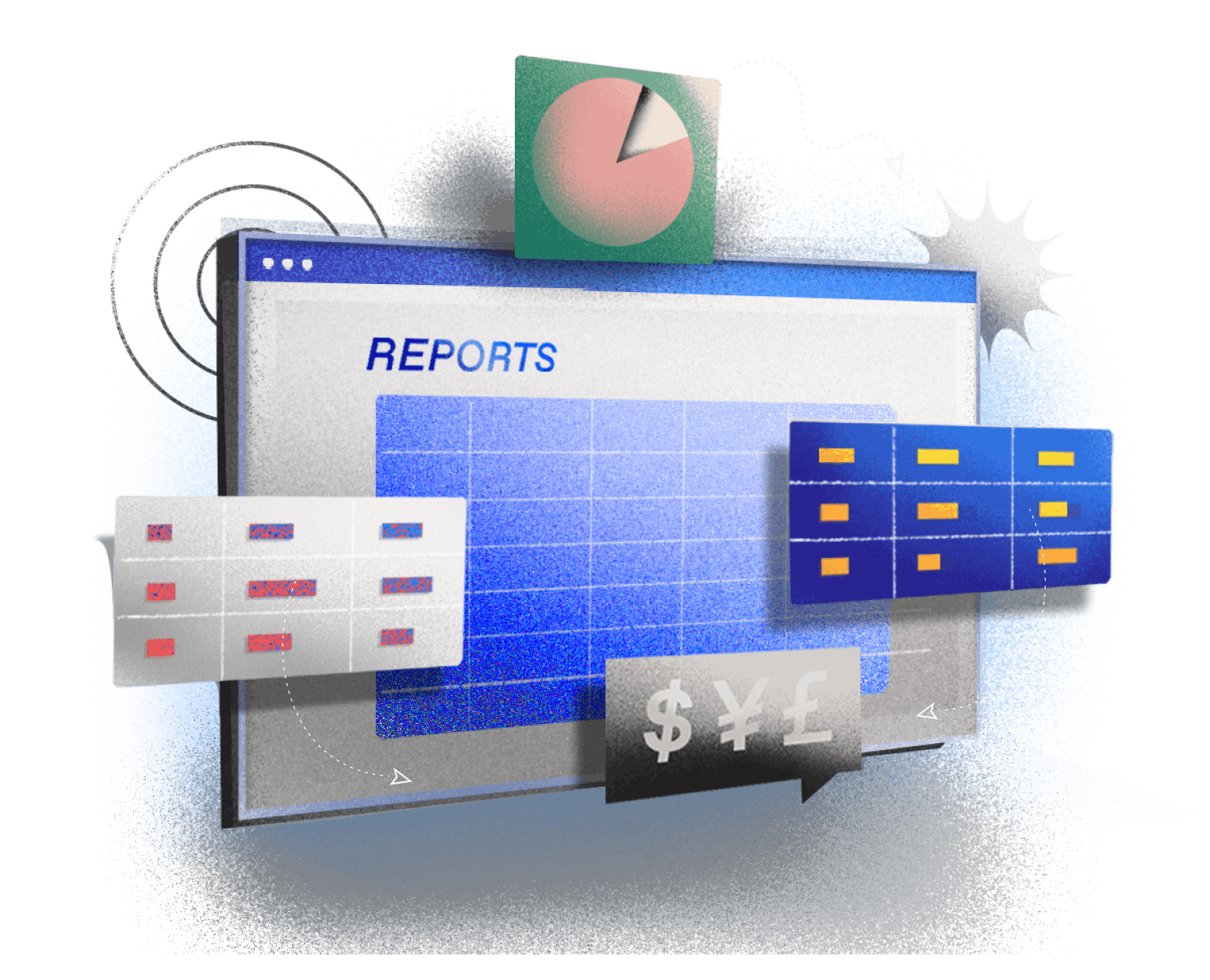At the core of every company are the products. If they stand out from competitors' products and appeal to consumers, you're on the path to success.
This is why it's crucial to track product data, including performance metrics. With this insight, it becomes possible to improve your products and determine which ones to focus on. When it comes to tracking such data, product reports are an invaluable tool. Read on to learn about product reports and the benefits they offer.

What is a product report?
A product report is a report that displays key data on the goods your business sells. Such data may vary depending on the needs and objectives of the product report. It may provide information on inventory, sales, discounts, net and gross revenues, etc.
The value of a great product report
A product report can help you make the most out of your product offerings. Some of the ways you'll benefit include:
1. Detailed insight into KPIs & accurate progress report
The primary objective of a product report is to enable you to make informed decisions in relation to your products. As such, for each of the key performance indicators (KPIs) you wish to track, it should provide detailed insight.
Beyond this, it also offers accurate progress reports. These will enable you to determine the effectiveness of the actions you take.
2. Understand product sales data
A key part of product management is tracking sales. Which of your products is performing well and why? Are there products that are losing popularity? These are some of the questions you should ask yourself in relation to sales.
If the demand for a particular product is rising, you may need to ramp up production. But, on the other hand, if there's a decline in demand, you need to find out the cause. Product reports can help with this. They give you a glance into the product type selling the most, when they're selling, and to whom.
This also lets you know whether you need to improve your product or develop new product lines.
3. Breakdown product costs
Beyond the total amount of products you sell, the costs you incur also significantly affect profitability. While direct costs may be easy to track, some are easy to miss. If this happens, actual business outcomes may not be as good as you think.
By preparing a product report, you'll be able to break down product costs fully. This allows you to identify areas that are pushing your prices up or reducing profitability.
4. Insight into customer needs
Regardless of how good a product is, it won't do well in the market if it doesn't meet market needs. Through B2B subscription reporting, your business can better identify consumer purchase trends. This may be in relation to your entire catalog or an individual product.
As such, you'll be able to determine which products to increase or reduce production. Also, depending on consumer preferences, it'll let you know whether it's time to release new products.
5. Precise cohort analysis
It's one thing collecting data and another one altogether drawing actionable insight from it. Cohort analysis is an analytical methodology that can help with this. It involves dividing and grouping data based on common characteristics.
In doing so, analyzing data and identifying patterns becomes much easier. As you may now imagine, product reports are an integral part of cohort analysis. By helping you track user behavior better, they enable you to improve retention.
6. Accurate and up-to-date view of product performance
Along with sales reports, product reports give you invaluable product data. As such, you'll have an up-to-date view of product performance. This will greatly enhance decision-making as product teams will have confidence in the information before them.
How to deliver excellent product reports
Every product manager knows that reliable product reports significantly improve decision-making. However, for your company to capitalize on this consistently, product managers should deliver such reports regularly. But it's not just about producing reports but reporting on the right things and delivering the information in an easy-to-digest format.
To achieve this, product managers should:
1. Cater to your audiences
Product performance goes hand in hand with consumer needs and desires. So, in each product report, it's essential to show how it satisfies market needs.
2. Proactively anticipate and answer questions
The goal of a product report is to guide the direction your company takes. As such, before you make any decisions, management teams will deliberate on key areas of interest. During this process, stakeholders may need clarification on different things.
As such, anticipating questions that may arise and proactively answering them makes product reports more robust.
3. Rely on visuals to show not tell
Human beings are primarily visual creatures. This means that it's easier to interpret and understand information presented in the form of images in comparison to text. Therefore, instead of telling stakeholders what you find, show them. Effective ways to present such data include graphs and charts.
4. Leave out unnecessary noise
While you want to present as much data as possible, you should be wary of information overload. Instead, determine the product report's objective and only focus on the relevant information.
5. Lead with an executive summary
One way to grasp and maintain your audience's attention is to let them know what they're reading and why. Therefore, ensure that you include an executive summary in every product report. It should clearly outline the objectives of the report. This will also help them analyze the data more appropriately.
Key metrics to track to improve product performance
For your company to make accurate future predictions, it's essential that product reports focus on the right metrics. Some of the key metrics to track include:
Monthly recurring revenue (MRR)
As a SaaS company, most of your revenues will come from repeat customers. As such, it's integral that you track the monthly recurring revenue. This metric helps determine whether subscriptions are increasing or reducing.
Customer lifetime value (CLV)
In the same vein with MRR, an integral part of your success depends on the total amount of money you make from each customer. In this regard, you should continuously monitor and work to increase customer lifetime value.
Customer acquisition cost (CAC)
While growing your customer base is essential, how you do it is important. If the cost of acquiring customers is high, it may take too long before you profit from them. It also increases your risk exposure in case your churn rate is high. So, it's important to keep track of your customer acquisition cost.
Daily & monthly active users (DAU/MAU)
For subscription businesses, how much your customers use your solution directly correlates with MRR and churn. Ideally, most, if not all of your subscribers, should use your service daily. This demonstrates that they find great value from it.
As you work to improve your value proposition, also monitor your daily active users and monthly active users.
Retention rate
As exciting as it may be getting new customers, it won't have a long-term benefit for your brand if you cannot retain them. While it's often overlooked, measuring your retention rate is important. It lets you know the proportion of customers you retain in a given time period.
Churn rate
Churn rate refers to the proportion of customers who stop using your service over a specific timeframe. If many customers leave, you'll lose out on their potential value in the long run. To prevent this, you should track your churn rate and swiftly address the contributing factors.
Get real-time product reports with ProfitWell Metrics
Evidently, product reports are an invaluable resource. However, generating them may be a little challenging. Fortunately, it does not have to be so. ProfitWell Metrics is a free tool from Paddle that you can use to track and analyze key metrics. Our retention reporting platform for customer success helps you track everything from retention and churn rate, customer acquisition cost, customer lifetime value, monthly recurring revenue, etc.
By tracking key metrics and providing actionable insight, it allows you to uncover growth opportunities and improve engagement and retention.
Product reporting FAQs
There are many things that come into play when developing product reports. As such, it's understandable if you're still unsure about some things. Some of the frequently asked questions and their answers include:
Why is product reporting important?
Ultimately, all business functions are aimed at increasing sales. For this to happen, you need to have a product that's desirable in the market and meets consumers' expectations. Product reporting gives you key insights into your products. This enables product teams to improve the value proposition while maximizing returns from products.
What is product management reporting?
Product management reporting refers to the process of tracking and analyzing key product metrics and then relaying the insight to stakeholders. Check out our subscription reporting platform for product teams to learn more.
Who is responsible for product reporting?
The product manager is the party responsible for product reporting. Their goal is to provide relevant product information to support decision-making and planning.




